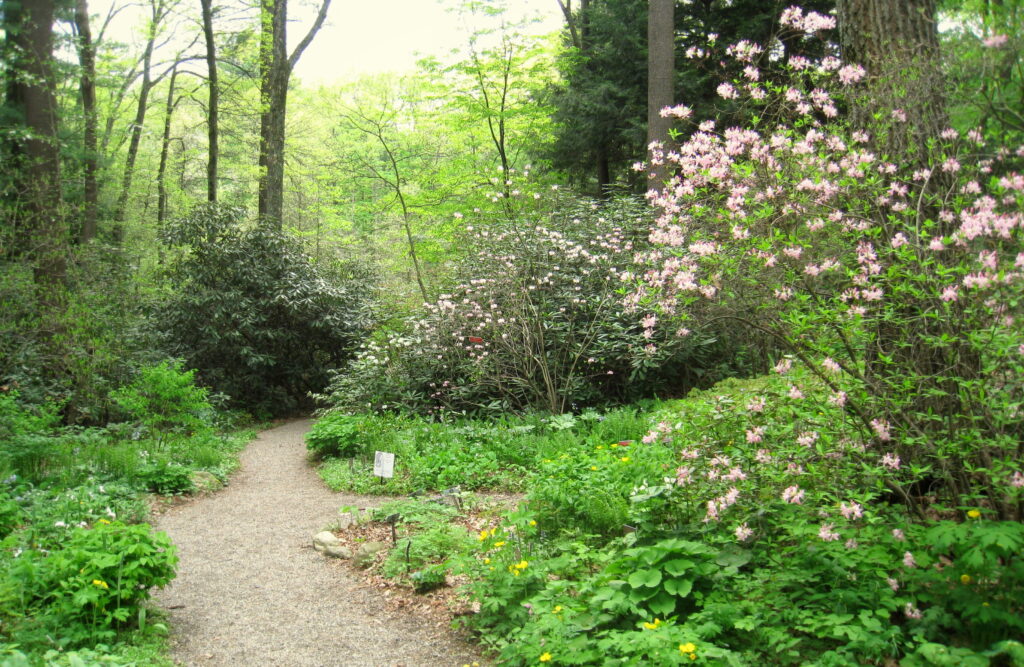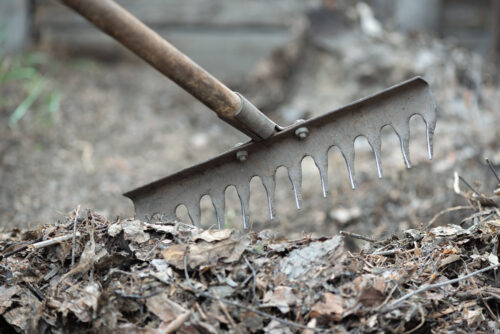The Garden in the Woods is unique among botanical gardens in its focus on native plant species. This focus teaches guests about the value of sustainable, native communities.
Nestled in a New England residential neighborhood, up a tree-lined, winding driveway is the 45-acre aptly named Garden in the Woods. While most botanical gardens devote only a fraction of their property to native plants, the Garden in the Woods showcases native plants throughout, with only a few non-native species mixed in.
By focusing on native plants and fostering sustainable plant communities, Garden in the Woods fosters local knowledge, propagates rare species of plants, and provides guests the resources to better know, love, and brighten their little corner of the world.
LOCAL DIVERSITY
When native plant communities thrive, we see more local diversity: both the vegetation and the pollinators and hungry birds native to that place flourish. What happens is that, over millennia, these species endure a distinct set of climatic and environmental factors so that, together, they develop some special adaptations that help them thrive together in a shared habitat. Bogs, for example, are acidic and nutrient-poor habitats common across New England. To live in these habitats, several bog plants adapted to lure and trap flies—becoming carnivorous plants—to avoid nutrient deficiencies.
While I am no stranger to botanical gardens, my first visit to the Garden in the Woods surprised me. I meandered through what looked like an untamed forest with unruly wildflowers butting up to the paths—this was unlike the delicately manicured hedgerows and dense, colorful flowerbeds that I usually expect at a professional garden. It turns out the natural look was what Will C. Curtis, the original landowner and architect, had in mind. It took me some time to train my eyes to notice what was hidden before me, but I soon saw an artful arrangement of species that most horticulturists forgo.
Curtis’s original goal was to propagate wild, native plants. Though native plants are beautiful, his work had an even more fundamental purpose. Native plant communities are sustainable plant communities: they are resilient, robust, and can foster even delicate ecological interactions, helping to preserve rare species. This mission is carried on by the Native Plant Trust, who owns the garden today. In addition to the garden, the Native Plant Trust also maintains plant sanctuaries throughout New England to protect areas where native plant communities are already thriving. Several feature rare species, which would likely be lost without the delicate and diverse ecosystem fostered by a community of native plants (and protected from foot traffic and bulldozers).
SUSTAINABLE COMMUNITIES
A robust native plant community can fend off invaders well, because each member of the community monopolizes certain resources and ensures that there are no gaps through which invaders can enter. When these communities suffer disruption—such as along roadways—the balance is thrown off and an opening is made for an aggressive, non-native plant to come in and render more delicate species extinct or to overwhelm and monotonize a landscape. This is what Curtis labored to prevent.
Of course, damaged plant communities can be restored, but they require some specialized care up front. There is knowledge unique to different species of plants, and prior to Curtis’s work, few other gardens or botanists were cultivating the knowledge to help non-ornamental plants thrive. Today, the Native Plant Trust serves to maintain a library of seeds and a greenhouse of seedlings—and the knowledge to help them thrive—that can be used to restore degraded areas, such as coastal wetlands damaged by Hurricane Sandy … or much more commonly degraded areas, like a overwhelmed patch of land in your neighborhood.
Maybe as spring rolls around, you and your neighbors may decide to spend a day removing the dominant, invasive vegetation together. But here’s the key, you must replant the area soon after with hardy, native plants. Otherwise, the invaders can return to colonize the empty space. The native plants will appreciate your watering and weeding at first, but after a season you may notice that the plot no longer needs you. If all goes well, the species you initially planted will be flourishing, but other species will have been welcomed into the community too. Instead of one species dominating the landscape, your neighborhood will get to enjoy a balanced landscape of colors, heights, and scents in this refurbished plot.
This is the knowledge that Garden in the Woods is preserving and sharing. By cultivating their own hardy, sustainable plant communities, building a storehouse of knowledge, and selling native plants, they enable people like you and me to transform a small plant environment from a monotonous landscape overrun by an aggressive invader, to a diverse, sustainable, and native community.
A GARDEN FOR EVERYONE
This garden is not just for students of botany. The Garden in the Woods is accessible to visitors of all kinds, from playful children to home gardeners, businessmen on their lunch break, or anyone who wants to spend time outdoors in a beautiful natural setting. By showcasing how beautiful the natural landscapes of North America can be and by providing these native plants for purchase, the garden is promoting interest in native plants outside of niche botanical circles and enabling visitors to reap the benefits of native plant communities in their own backyards.
If you are ever lucky enough to visit this gem, look out for the trillium flowers. These iconic tri-petaled flowers bloom in early spring and are not typically commercially available. The Garden in the Woods has 21 of the 39 species native to North America, and even a few rare albino specimens.
Or, if you cannot schedule a visit just yet, check out the Native Plant Trust’s awesome online plant identification resource, GoBotany. You can plan your own nature walk and learn, at home, a great deal about plants native to your home. As you familiarize yourself with your local environment, you will discover what is native in your neighborhood and what is not. You will likely find some aggressive, invasive plant somewhere in your community—and then you may be inspired to round up your neighbors and take down those invaders.






